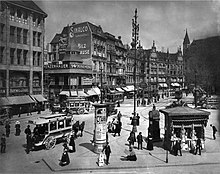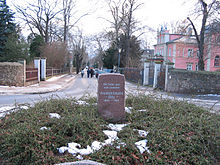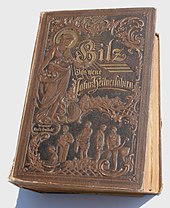Friedrich Edward Bilz
Friedrich Eduard Bilz (born June 12, 1842 in Arnsdorf near Penig ; died January 30, 1922 in Radebeul ) was a German naturopath and life reformer . He is also referred to as the father of popular naturopathy. His books have had a circulation of approximately 3.5 million copies and have been translated into twelve languages. After his death, he was buried directly to the right of Karl May 's tomb , with whom he was a friend.
Life
Bilz did an apprenticeship as a weaver from 1856 to 1859 and after a period of wandering settled down in 1860 as a journeyman weaver in Meerane . Until 1867 he worked as a journeyman weaver in a factory. Due to the bad working conditions in the factory, Bilz suffered from stomach cramps and developed lung problems. Bilz met the Meeranerin Marie Auguste, daughter of the weaver Johann August Kreil, whom he married in 1868 after the birth of their daughter Marie Lina. Bilz then worked independently with a family weaving mill.
After the father-in-law bought a house for the family, Bilz opened a grocery store there at Albanstraße 18 in 1872. He gave up weaving and became a grocer.
In the same year 1872 there was a smallpox epidemic . Meeraner citizens, who did not consider the vaccinations ordered to be sufficient health care, founded the Association for Health Care and Naturopathy , of which Bilz also became a member. The association held lectures and courses on naturopathy. However, since many books were incomprehensible because of the foreign words used, Bilz collected all understandable instructions for a healthy lifestyle and medical treatment. While his wife successfully ran the lucrative business and cared for the family, Bilz tried many of the instructions on himself. He taught himself naturopathy and gradually acquired a nature-oriented worldview. Financially secured by the income from the grocer's shop, Bilz wrote his first book, The Human Happiness in Life. A guide to health and prosperity through a return to natural law. Family friend and family treasure for the healthy and the sick. At the same time a contribution to the solution of the social question , which was self- published in 1882 .
Next came The Key to Full Human Happiness, or Repentance to Natural Law. The Chemnitz manufacturer and patron of naturopathy Johann von Zimmermann suggested revising the naturopathic appendix and publishing it as an independent book. So in 1888 the book "Bilz, the new healing method, a reference book for everyone in healthy and sick days" was created.
The work, popularly known as the Bilz book , was called “The New Healing Procedure” in the following editions. Textbook of natural healing and health care”. In the same year Bilz founded the publishing house F. E. Bilz . The Bilz book quickly became known beyond Saxony. The secret of success lay in the simple explanation of complicated medical facts and in the understandable healing recommendations that could be practiced in every household. In 1925 more than 2.5 million copies had been sold and the book was published in 12 foreign languages.
In his textbook, Bilz propagated, among other things and especially for young people, low-impact foods, sufficient physical exercise in the fresh air or sleeping on hard mattresses.
In 1889 the family gave up the grocery store and moved to Dresden , then in 1890 to Oberlößnitz , today a district of Radebeul . There he had bought the property of the Viennese private owner Richard Strubell on a section of the Albertsberg vineyard above Haus Albertsberg , on which he opened a small sanatorium for his naturopathic institution (later Kurhaus I) for initially 15 patients in 1892 in the existing classicist building ( Bilz- sanatorium ).
Since this building quickly became too small, Bilz had Kurhaus II built to the east of Kurhaus I, the so-called Schloss Lössnitz , by 1895 . In the same year he also bought the Jägerberg property , and the Hantzsch villa became Haus Bilz . From 1896 the bathhouse (Kurhaus III) was added to the north behind Kurhaus II at a 45-degree angle, and in 1898/1899 Kurhaus IV was put into operation on the nearby Jägerberg.
In 1898 Bilz-Verlag, which had been managed by Bilz's son Arthur Ewald Bilz (1872-1941) since 1893, moved to Leipzig. In 1899 a branch was opened in Paris and in 1900 in London.
In 1902 Bilz developed together with the Lippe merchant and drinks specialist Franz Hartmann the Bilz-Brause , which became Sinalco (sine alcohole = without alcohol) in 1905.
In 1905 he opened the Bilz-Licht-Luft-Bad ( Bilzbad ) above the Lößnitzgrund . In 1906 Bilz' youngest son Willy Johannes Bilz (1884-1965) and his wife Margarete Ottilie took over its management, while his eldest brother Max Alfred Bilz (1877-1939) had succeeded him as director of the sanatorium since 1905. The Bilzbad has had 1,000 changing rooms since 1906. From 1912 it was also known as the Undosa wave pool , due to the installation of the Undosa wave machine (Undosa in German translation: "the wave kingdoms"). This first wave machine was presented in 1911 at the International Hygiene Exhibition in Dresden and immediately bought by Bilz. The wave pool can still be used today.
In 1907 Bilz published a 1130 -page science fiction novel (In Hundred Years) , which takes place in the year 2048 and in which Bilz sees his political, social and life-reforming ideals fulfilled. Unlike his naturopathic books, this utopian novel does not appear to have met with any success. It was not distributed further and is now only available second-hand.
Friedrich Eduard Bilz died on January 30, 1922 in his hometown and was buried in the square directly to the right of his longtime friend Karl May in the Radebeul-Ost cemetery. The simple tomb made of stone and cross, which is now a listed building, has the inscription "Nature was my guiding star".
Bilz products
Bilz shower

In addition to his books, FE Bilz was also known far beyond Europe's borders for an alcohol-free soft drink, the Bilz-Brause (actually Bilz' Brause ).
In 1900, the Lippe merchant and drinks specialist Franz Hartmann approached Bilz. He traveled to Oberlößnitz with the recipe for a lime extract . Bilz liked the idea because, in his opinion, the mineral salts and fruit acids contained in the fruit are health-promoting and the fructose passes on its energy directly to the blood. Bilz and Hartmann thus developed a natural fruit drink from tropical fruits and local types of fruit, the "Bilz Limetta" , which was called "Bilz-Brause" from May 1902 .
A major advertising campaign was launched in 1902 with the success that the first international, non-alcoholic beverage brand of European origin was established. Imitators soon followed. Business disagreements between the partners arose around 1905, and from then on Franz Hartmann decided to look for a new name for the "Bilz-Brause" . A competition gave rise to the name Sinalco (Latin sine alcohole - without alcohol).
The name “ Bilz ” is still used in Chile today for a red fizzy drink, which, however, goes back to one of the imitator products of Andres Ebner Anzenhofer, a Bavarian who emigrated to Chile.
Other Bilz products
The convinced naturalist and resourceful health entrepreneur Bilz developed and sold a whole range of other products that were intended to support his health philosophy. Such "reform foods" were, for example, Bilz Nutrient Salt , Bilz Nutrient Salt Cocoa , Bilz Nutrient Salt Chocolate and Bilz Malt Coffee .
The friendship between Eduard Bilz and Karl May
Eduard Bilz was a reader and friend of Karl May . The connection began at the latest in 1896, when Emma May, Karl May's first wife, spent several weeks recovering from influenza in the Bilz sanatorium . For later it is documented that May, together with Klara , his second wife, took part in the annual rose and wine festivals that Bilz gave for the spa guests. In 1907, May herself took a cure at the Bilz sanatorium. In a wedding photo of a Bilz daughter from 1907 you can see the married couple May and Bilz sitting next to each other.
Bilz was a limited partner in the company "Ustad-Film, Dr. Droop & Co." This company produced three May silent films in 1920.
Karl May, in turn, took Eduard Bilz as a model for the "former barber Hermann Rost" in the volume "Weihnacht!" from 1897: "He is now one of the most respected naturopaths in the East and ... a reader of my travel stories."
honors
A street in Radebeul has borne his name since 1935, until the end of the Second World War it was today's August-Kaden- Straße. Since 1945, today's Eduard-Bilz-Strasse has consisted of part of the former Strakenweg up to Augustusweg , from there the former Sophienstrasse , from the crossing Nizzastrasse the former Gabelsberger Strasse to the crossing Meißner Strasse and south of Meißner Strasse the former Lutherstrasse. In 2002, the square at the intersection of Eduard-Bilz-Straße and Augustusweg (the former Königsplatz) was also renamed Eduard-Bilz-Platz .
For a long time, the Bilz stone stood on Eduard-Bilz-Platz , which was moved to the Bilzbad in 2017 after the memorial was erected.
The three towns of Burgstädt , Lunzenau and Penig in the vicinity of his birthplace Arnsdorf created the Bilz health and active region with a Bilz hiking trail, a Bilz cycle route and a Health Day .
The high school in Penig bears the name of Friedrich Eduard Bilz.
Bilz Bund
The Bilz Association for Naturopathy e. V. was founded in 1995 in Radebeul , the city where Friedrich Eduard Bilz worked. He has set himself the task of reviving and publicizing the tradition of naturopathy in the sense of FE Bilz for today's modern times, since the topic was kept secret in GDR times.
The five classic pillars of naturopathy , nutritional therapy , exercise therapy , water therapy , phytotherapy and regulatory therapy, are scientifically revived and their application taught.
plant
healthcare facilities
-
Bilz sanatorium in Oberlößnitz, today Radebeul , with a large open-air and walking area
- Loessnitz Castle in Oberloessnitz, former Kurhaus II of the Bilz Sanatorium
- Jägerberg in Oberlößnitz, former Kurhaus IV of the Bilz sanatorium with a large open-air and walking area as well as a private residence (Haus Bilz)
- Bilzbad in Niederlößnitz, now Radebeul , with a large open-air area and wave pool
writings
Bilz book
- Friedrich Eduard Bilz: The new healing process. Textbook of natural healing and health care. Publisher FE Bilz, Dresden 1888.
- Friedrich Eduard Bilz: The new naturopathic treatment. Textbook and reference book on natural healing and health care. Publisher FE Bilz, Dresden, Radebeul. 20th edition 1894.
- Friedrich Eduard Bilz: The new naturopathic treatment. Textbook and reference book on the natural way of life and healing as well as modern health management. With 3 folded fold-out plates and many illustrations, some in colour. 2 volumes. anniversary edition. FE Bilz GmbH Verlag, Dresden-Radebeul 1938.
- Friedrich Eduard Bilz, Hans Balzli : Natural healing methods. Reference book for the natural way of life and healing; with a fold-out colored plastic model of the human. Keyser, 1956.
social fonts
- Friedrich Eduard Bilz: The human happiness in life. A guide to health and prosperity through a return to natural law. Family friend and family treasure for the healthy and the sick. At the same time a contribution to the solution of the social question. Self-published, 1882.
- FE Bilz: The state of the future. State institution in the year 2000. New world view. Everyone is assured a happy and carefree existence. FE Bilz Verlag. Leipzig, Radebeul near Dresden, May 1, 1904.
- FE Bilz: The natural state. Proposals for a natural legislation. By realizing the same, today's mass misery, which hits Germany particularly hard, would soon be remedied. 1st-20th Thousand (first edition), FE Bilz, Leipzig, Dresden-Radebeul, 1922.
- Friedrich Eduard Bilz: The Key to Full Human Happiness or Repentance to Natural Law .
narrative work
- F[riedrich] E[duard] Bilz: In a hundred years. Richly illustrated novel. Leipzig, Dresden-Radebeul: Bilz, 1907. Digitized edition
literature
- Frank Andert (Red.): Stadtlexikon Radebeul . Historical handbook for the Lößnitz . Published by the Radebeul City Archive. 2nd, slightly modified edition. City archive, Radebeul 2006, ISBN 3-938460-05-9 .
- Friedrich Edward Bilz; Jürgen Helfricht : Bilz' health cookbook and Bilz biography (with a biography of the legendary Saxon naturopath by Jürgen Helfricht) . dr Krickau, Dresden 1999, ISBN 3-00-003425-0 .
- Jürgen Helfricht : Friedrich Eduard Bilz (1842-1922) - doyen of naturopathy in Saxony . City administration of Radebeul/Sinalco AG, Radebeul/Detmold 1992.
- Jürgen Helfricht: The recipes for success of Saxon natural healers . Taucha 2004, ISBN 3-89772-077-9 .
- Jürgen Helfricht: Friedrich Eduard Bilz. Naturopath, Philosopher, Entrepreneur . Notschriften, Radebeul 2012, ISBN 978-3-940200-74-7 .
- Marina Lienert: Friedrich Eduard Bilz . Publisher: State Association of Saxon Homeland Security eV:. Communications from the State Association of Saxon Homeland Security eV , 1/2012, 2012, ISSN 0941-1151 (pp. 52-57).
- Marina Lienert, Katrin Roschig: Radebeul, a center of naturopathy - life and work of Friedrich Eduard Bilz (1842-1922). In: Dresden History Association (ed.): Kulturlandschaft Lößnitz-Radebeul (= Dresdner Hefte . No. 54), Verlag Dresden History Association, Dresden 1998, ISBN 3-910055-44-3 , pp. 77-83.
- Hans-Dieter Steinmetz: Karl May and Friedrich Eduard Bilz. Another building block. In: Announcements of the Karl May Society . No. 89, 1991, p. 13.
web links
- Literature by and about Friedrich Eduard Bilz in the German National Library catalogue
- Works by and about Friedrich Eduard Bilz at Open Library
- Bilz Bund
- Health entrepreneur Bilz: With naturopathy to fame and fortune. In: spiegel.de. January 11, 2019.
- Friedrich Edward Bilz (1842–1922)
itemizations
- ↑ a b Information on Friedrich Eduard Bilz ( Memento of December 29, 2006 in the Internet Archive )
- ↑ Friedrich Eduard Bilz (1842 to 1922); Naturopath, life reformer, businessman ( April 3, 2005 memento at Internet Archive )
- ↑ Information from the front page of the 1925 edition.
- ↑ Friedrich E. Bilz: The new naturopathic treatment. Teaching and reference book of natural healing and health care. Leipzig 1898, p. 1147.
- ↑ State Office for the Preservation of Monuments in Saxony and the City of Radebeul (ed.): City of Radebeul . Monument topography Federal Republic of Germany. Monuments in Saxony, SAX-Verlag, Beucha 2007
- ^ a b Friedrich Eduard Bilz (1842–1922)
- ↑ Karl May Chronicle I, p. 535
- ↑ Hoffmann: Karl May , as note 38, p. 73
- ↑ Cf. Rudolf W. Kipp: The Lu Droop Story . In: M-KMG 38/1978, p. 4.
- ↑ Hans-Dieter Steinmetz, like note 37, p. 17
- ↑ Karl May: Collected Travel Tales Vol. XXIV: Christmas! Freiburg 1897, p. 619.
- ↑ Website of the Bilz health and active region
- ↑ Bilz Federation for Naturopathy eV
- ↑ Bilz, F(riedrich) E(duard): The natural state. Proposals for a natural legislation. By realizing the same, today's mass misery, which hits Germany particularly hard, would soon be remedied. 1st-20th thousand (first edition)
| personal data | |
|---|---|
| SURNAME | Bilz, Friedrich Edward |
| BRIEF DESCRIPTION | German naturopath and life reformer |
| BIRTH DATE | June 12, 1842 |
| PLACE OF BIRTH | Arnsdorf b. Penig |
| DATE OF DEATH | January 30, 1922 |
| PLACE OF DEATH | Radebeul |








